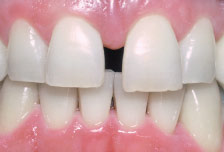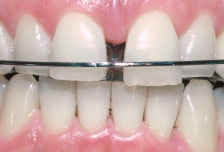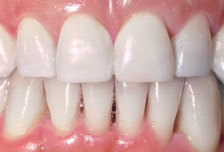Minor Tooth Movement
How do you know if your orthodontic needs are minor?
Dear Doctor,
I need to have a gap closed between my two front teeth so I look great for my wedding. My dentist said that this is minor tooth movement. What does that mean and how long will it take?
 |
| Figure 1: An example of a large space (diastema) between a patient's front teeth that she wanted to close. |
 |
| Figure 2: A removable orthodontic appliance was used to close the space. |
 |
| Figure 3: The final orthodontic result with the space closed. |
Dear Amanda,
Minor tooth movement usually refers to relatively simple movements of single or a few teeth by orthodontics or tooth straightening (ortho-straight, odont-tooth). Minor or simple movements also mean the teeth don't have to be moved very far, maybe a millimeter or two, just like in your case of closing a small gap between two front teeth. It also means that the appliances used are relatively simple in design and because the movements are minor the procedure generally takes months, not years.
There are a few caveats, important things that need to be observed and assessed to make sure that these minor movements can be carried out simply. As with everything in medicine and dentistry, correct assessment or diagnosis of the problem is essential to correct treatment. Take your situation for example, a small gap between your front teeth:
- Is there enough room to close the space without creating a bite problem with the lower teeth?
- Are the roots of the teeth in reasonably good position to allow for minor tooth movement to close the space? Radiographs (x-rays) will be essential to assess this and models may also be necessary for study purposes.
- Is there an involuntary tongue habit that has pushed the teeth forward and created the gap? — This could be difficult or impossible to fix.
- Is there a large “frenum” the little frond of tissue that runs between the teeth and up into the lip causing the teeth to separate? This may require a very minor and routine surgery to remove it and allow the teeth to stay together after space closure.
- Are the surrounding periodontal (peri-around, dont-tooth) tissues, the gum tissues and the bone healthy?
An orthodontist, a dentist who has taken advanced training in growth and facial development and tooth straightening mechanics; or an experienced general dentist who has taken advanced orthodontic training can answer these and other questions and carry out the minor tooth movement safely and uneventfully.
Depending upon the assessment, and bearing in mind that each person's diagnosis is individual, there are generally a few options for minor tooth movement treatment:
- Clear retainers — these are a computer generated series of clear retainers customized for your bite to move the teeth.
- Removable orthodontic retainers to which small springs or elastics are attached to facilitate the minor tooth movement.
- Traditional fixed orthodontic appliances, that are most commonly known as “braces” — small metal or clear brackets bonded to the teeth and through which tiny wires fit to move the teeth.
Whatever method is used for the tooth movement, it is important to understand that even when the teeth have moved into the new position and the space is closed, they must be retained or kept in the new position until the bone stabilizes around the teeth so that they will remain in the new position by themselves. This will mean wearing retainers for a few months.
From a planning standpoint this means you need to allow adequate time for the whole process, atleast several months to make sure your wedding smile is just right.




